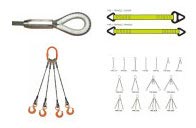Those in the material handling industry consider lifting slings as a necessary tool for rigging and hoisting. When the proper sling is used for a unique application, easy and safe lifting of heavy loads is possible. The most important consideration to make when choosing lifting slings is the material. Below, we want to highlight the top options:
Wire Rope Slings are constructed from strands of steel that is carefully braided into a strong rope. When compared to other sling materials, stainless steel wire rope has the lowest cost for lifting capacity. The material is also highly UV and abrasion-resistant
Chain Slings are ideal when used in rugged applications. These slings are stronger than all other sling types, so they are used to carry the heaviest loads. The slings hold up with repeated use, and they even perform in temperatures of up to 400F.
Nylon Slings are economical and lightweight, and so they are a popular choice in many lifting applications. Nylon web slings are flexible and easy to use. Polyester slings are also commonly used synthetic webbing materials, and they should not be used interchangeably with nylon slings. Use nylon for its stretch and used polyester when you need a soft and flexible material. Nylon is a great material to choose when slings are used in environments that have grease, oils, aldehydes, and alkalies. It would help if you did not use nylon slings near bleaching agents or acids.
Make sure to take the time to choose the right sling for your application. Nothing is more important than safety, and it is never safe to use the wrong tools for lifting and rigging.
Wire Rope